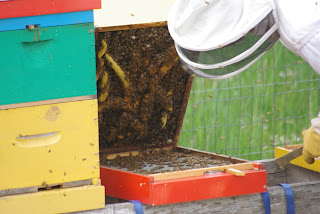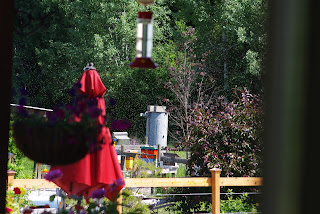 |
| Deep boxes and frames ready for creating new hives |
Well, okay, the honey house is in our dreams, but one day...!
It’s been a busy week with the bees. On Saturday, we had to
prepare the hives for re-queening. This year, we are trying to requeen with
queen cells, rather than using proven queens. It just stretches our ability a
bit further, and since we have a wonderful source for queen cells right now, we
will use it.
 |
| Unloading full honey supers from the second bee yard. |
Preparation meant cleaning out the queen castles that we had prepared in the spring, moving those hives to the large deep boxes so they can have a regular hive, and getting some new frames from some of the other hives, including the Hawaiians, to use as a foundation for the queen castles again. Doing this will add to the number of hives we have once more – essentially creating splits. When we clean out the queen castles, we open one nuc at a time. These nucs consist of three frames each. We check them to see that there is new brood on the frames; this means there is an active queen in that nuc. We check the pattern she is using for laying her eggs – we want to see almost every cell filled with larvae, with the odd open spot. Too many open spots or random clumps means that she is not as strong as she should be.
 |
| One-way screens allow the bees to get out of the honey super, but not back in. |
We take those three frames and move them into a separate deep box, add some more empty frames (preferably ones that have already got some built up comb on them, though) and those hives are ready to go. The three-frame area is just not big enough, so now they will have room to grow.
With the queen castles empty, we then went to the other hives that were already established. They need to be checked regularly anyway, so now was the time (despite the bees being especially peeved at us, and letting us know! It was a 9-sting week!). Hives that were especially strong donated one or two frames to restock the queen castles. We added queen cells to those queen castle nucs the next day and will check them in about a week. Hives that were not as strong donated more frames to the castles and were marked to get a new queen as well. We had three of those, and the queen cells were put in on Sunday.
 |
| Hot days and crowded hives lead to a lot of bearding on the outside. |
While we were out there getting stung anyway, we decided to put in the one-way screens between the honey supers and the hives. This would allow the bees in the super to get out, but no more would be able to go back in, leaving them empty (or almost empty) for us to extract the honey. We pulled the supers and set them in the shop to warm up, making extraction easier. We also pulled and extracted the Ross Rounds; our bees did a beautiful job of these, and we are very excited to have more next year.
Extraction was earlier this year than last, (mostly because
we ran out of honey supers so had to empty what we could so they can go back on
the hives) and the end product is incredible. The honey has a wonderful dark
color and a rich taste with locust and floral undertones. It runs nicely, and
is nowhere near as thick as last year – thankfully – because of the less arid
conditions this year. The bees and Mother Nature were smiling on us in 2016.
We will have one more extraction to do later in the year, hopefully, so our honey buckets are full again! Woo hoo!
 |
| Here comes the honey. The white flecks are wax from the comb totally harmless (actually, very healthy) so we filter it out. |
 |
| I don't always put honey in my tea, but when I do, it is fresh from the hive! |
 |
| Full Ross Round frames!! |
 |
| This is the honey in the comb, a delicious delicacy. (Ross Rounds) |
 |
| This is a very full frame of honey, the first of many! |













































